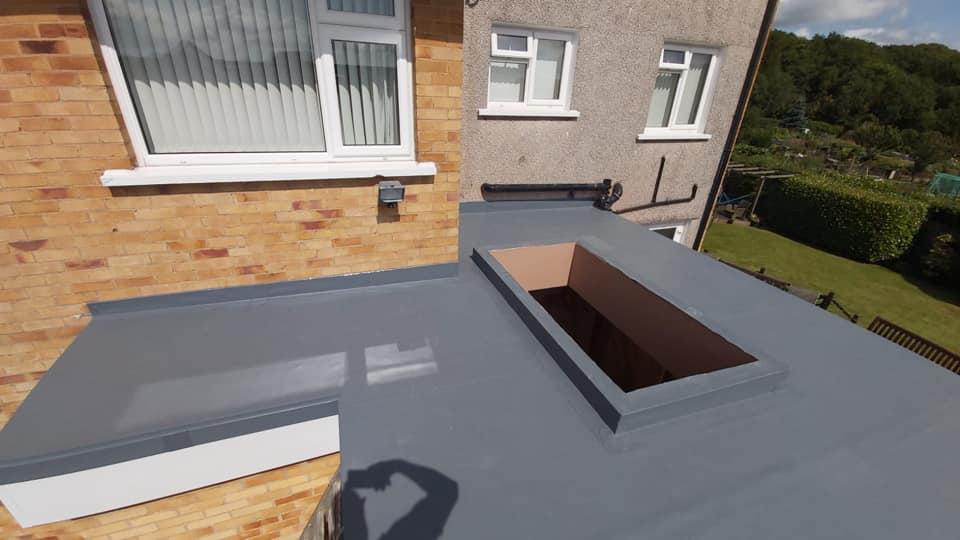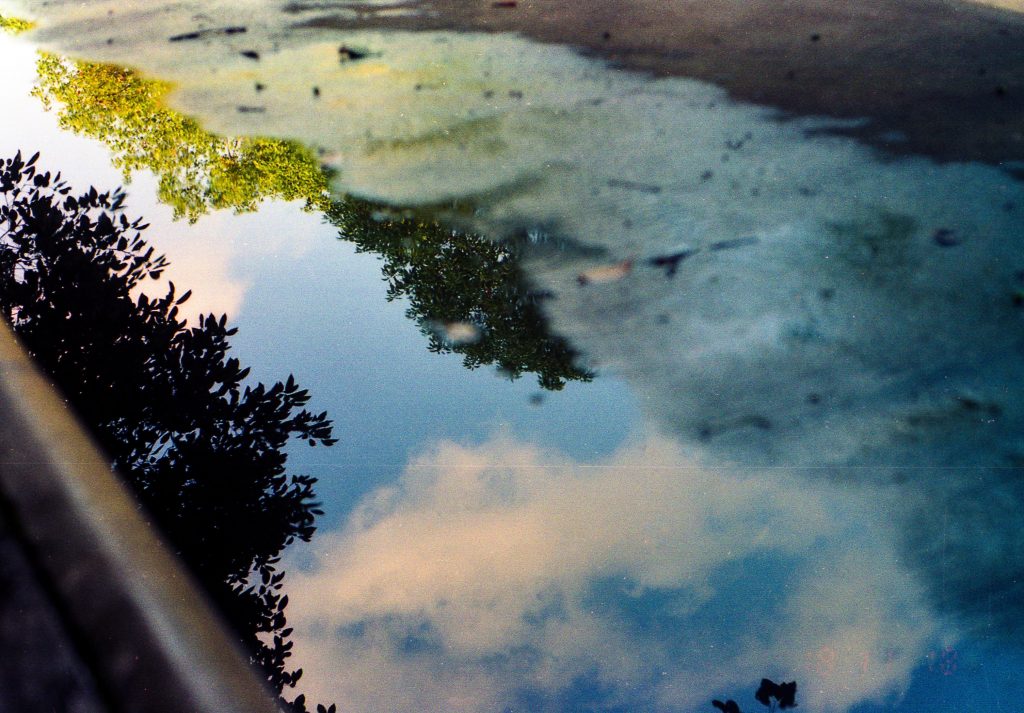While a well installed, properly maintained, flat roof can last for many years, it would be misleading to say that flat roofs never incur any problems. Like all roofs, they face the brunt of our erratic weather patterns, and do so without the relative shelter that a traditional pitched roof might offer.
Flat roofs are great for a host of reasons, but it’s important to know and be able to recognise some of the most common issues they face, and understand what you can do about it. While some problems like a blocked drain might be quite easy to resolve yourself from atop a ladder, if you’re in any doubt, don’t hesitate to call the professionals!
1. Standing Water
Though it may sound comical, water really is your flat roof’s worst enemy! Standing water on a flat roof can be caused by various factors, for example if a roof’s slope isn’t properly calculated or installed, or if the drainage system is blocked. The water will simply have no choice but to stay put.
‘Ponding’ (our term for areas of standing water on a flat roof) can also occur if the roof surface has dipped or warped, which can sometimes be a result of poor installation, thermal damage, or simply old age. Standing water on your flat roof is not something to take lightly, and the cause behind the ponding should be investigated immediately.
When water is left to stand for periods of time on your roof, it can cause damage to the surface material of your roof and the additional weight of the water can cause problems for the structure of the roof itself. If left for too long, water leaks into the roof space or through to the occupied space below are inevitable. Once the roof surface has been penetrated by water, problems like rot, mould, and fungus can severely compromise the roof structure.
What Should You Do?
Noticing a water leak inside your home or commercial building is often a sign that standing water has been left too long unnoticed. Regular inspections of your roof (we recommend a full roof inspection at least once a year) will alert you to any areas of ponding as soon as they appear, so you can try to fix the cause of the problem before it becomes a major issue. If you live in an area with frequent snow or heavy rainfall, a quick check after each weather event is a good idea.
2. Surface Deterioration
This is a broad problem that encompasses cracks, blistering, rips, or any other visible signs of damage to the surface of your flat roof. Surface deterioration is generally more common with felt or asphalt roof constructions, than with EDPM rubber-based applications.
Damage to the surface of your flat roof is an easy one to spot during a roof inspection. As a general rule, it is expected that your roof surface condition will deteriorate over time as a regular part of aging – hence why we don’t claim that your flat roof will last forever.
However, normal surface wear-and-tear can be exacerbated by several factors, including:
- Thermal damage – continual expansion and contraction of the roof surface material can lead to cracking over time. This may be particularly noticeable at the joins between roof materials, like the membrane and flashing around an upstand. If you live in an area with vast fluctuations of temperatures between the seasons, the lifespan of your roof may be reduced because of this.
- Footfall – great care should be taken when accessing the roof for inspections of the roof itself or other rooftop components (like chimneys, lift housing, or air conditioning units) to avoid causing depressions in which water might sit, or damage to the roof surface.
- Organic growth – if standing water is an issue on your roof, or your roof is surrounded by trees that like to shed their leaves, you may find organic growth like mould, lichen, or algae on the roof surface. This can permeate the roof material and can make water infiltration more likely.
- Trapped moisture – If you have previously had a leak on your roof, trapped moisture below the roof’s surface may expand and cause blistering of the surface material.
What Should You Do?
Sometimes, a small area of damage can be spot-fixed to prolong the life of your existing roof, and we can provide emergency repairs if your roof is damaged in a storm. Keep debris on your roof to a minimum with regular inspections and cleaning. However, if blistering, cracks, or rips are present across a large portion or your entire roof, the only course of action is a full replacement. Consider a harder-wearing roof surface like EDPM for your replacement roof.
3. Ineffective Drainage
Blocked drains, insufficient drainage allowances, and bad workmanship can lead to water damage on your flat roof. ‘Roof plumbing’ is what we call everything to do with getting water off your roof and into the drains – and it is a vital aspect of your roof’s design and function. A traditional pitched roof essentially acts as one big drain, directing water swiftly and effectively into the surrounding gutters. Due to the design of a flat roof, this is not such a simple process.
Although they’re called ‘flat roofs’, they are not actually flat. Flat roofs require a slope of at least 1:40 for effective water drainage, which can easily be included into your roof design. But it doesn’t end there. You also need to consider the size of the gutters, any internal drainage, down-pipes, and overflows. With a flat roof, it’s likely you will only have a gutter on one side, at the bottom of the gradient, as opposed to a pitched roof which will have one each side. The roof plumbing must be able to cope with the volume of water all coming in the same direction.
Furthermore, debris from surrounding trees, animal or bird’s nests, or items like plastic bags or balls can easily cause problems by blocking a gutter or drainpipe without your knowledge, as it is less visible than on a pitched roof.
If the roof drainage is not sufficient, or well maintained, it can cause damage to the roof surface and sub-structure through standing water and leakage.
What Should You Do?
Keep your roof and gutters clear of debris. Regularly inspecting your roof can mitigate any ongoing problems. Report to your installers or roof maintenance team if you see any signs of depressions or bowing in the roof structure that may be caused by standing water or a leak.
To deal with the amount of rain we get in the UK, ensuring good drainage of your flat roof should be paramount from the initial design of your roof, right through installation and your ongoing maintenance plan. A professional flat roofing team will ensure your flat roof will have all the necessary provisions to drain water efficiently and effectively.
4. Poor Installation
Unfortunately, poor workmanship on the installation of your flat roof can result in many of the issues we have already talked about. The lifespan of a flat roof can be anywhere from 20 to 50 years, depending on the roof material you choose and the site specifics. If you are noticing problems with your flat roof far earlier in its lifespan than you expected, it’s likely to be a problem due to poor-quality workmanship.
Whilst a roof can be designed to a specific slope to aid water drainage and prevent ponding, if this is not accurately executed on installation, the planning will have been for nothing. Uneven surface application on an asphalt roof can increase the chance of the roof surface blistering. Ill-finished joints and flashing can lead to leaks and the need to replace the roof prematurely.
What Should You Do?
Employing experienced flat roof installers to fit your new roof will help protect your home or commercial building against some of the most common problems faced with flat roofs.
Contact Flat Roofing Professionals
Our professional team at Sureseal Flat Roofing has a proven history of happy customers and successful projects behind us. We will make sure the plans for your roof design are followed to the smallest detail. Expert finishing will mean you don’t have to worry about standing water, leaks, surface damage, or inappropriate fittings. Our on-going maintenance and inspection services will ensure your roof will last for as long as possible, and you will avoid costly replacements before they are due.
To find out more about the installation and maintenance of a flat roof or to obtain a free quote for your project, contact the Sureseal Flat Roofing team today. We’re ready to help.



